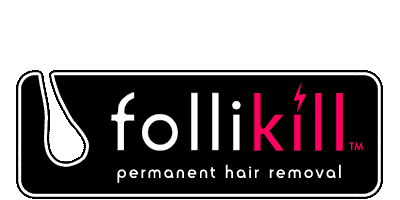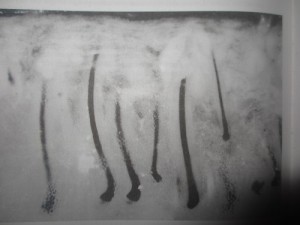Electrolysis And Black Hair
When one speaks of “black hair” there is generally a preconceived notion about its texture and its nature. There is so little research done into hair follicles and electrolysis in general that I can show you only 1 photo that relates to electrolysis and black skin. The image below seems to be the only one in existence of a hair follicle from a person of African descent (I couldn’t find this online either so this is an picture of an image in a textbook).
There is a prevalent myth that the hair follicles of black people are extremely curved like the letter C, however, the image to the left represents a more accurate picture of what is under the skin of people with various types of tightly curled or “kinky” hair. There is a slight bend in the follicle and the texture of the hair becomes evident only once it breaks the skin. As you can see in the image there are also several straight follicles alongside the slightly curved ones.
Special Considerations For Electrolysis And Black Hair
On black clients I’ve noticed that the hairs that are in the active growing phase have more or less straight follicles and the insertions are very easy. As hair moves from the active phase of growth into the resting phase the hair becomes tougher to treat. The hair often grows in a different direction above the skin than it does beneath, therefore, I must take great care with my insertions to ensure I deliver a good treatment.
In order to achieve the best treatment outcome it is even more important that someone with coarse, curly hair come for regular appointments in order to treat the hairs as they emerge from the skin. At this point they are more likely have the short, straight follicles so they are very easy to treat effectively using either thermolysis or the blend. Once the hair is in the resting phase it has been my experience that both the blend and thermolysis offer similar results, but those results depend entirely on the skill of the electrologist.
A perfect insertion and proper timing are crucial to the success of electrolysis and black hair.
Whether you’re using thermolysis or the blend, the hair follicles respond better to a treatment that takes into consideration the specific needs of a curved follicle. I often use a manual technique on black hair simply because I think the automatic timing methods don’t allow the time to position the probe properly (due to the curvature of the follicle) to make certain that the target areas are obliterated by the current.
As I’ve said many times before, all hair and skin types can be treated successfully with electrolysis. The key is to find someone who can provide the appropriate treatment for your hair type so you can achieve your hair removal goals as quickly as possible.
Further Reading:
https://www.follikill.com/2013/12/28/electrolysis-and-black-skin/
https://www.follikill.com/2014/02/20/distorted-follicles/
https://www.follikill.com/2014/02/27/black-dots-after-electrolysis/
https://www.follikill.com/2013/11/27/thermolysis-vs-blend/

